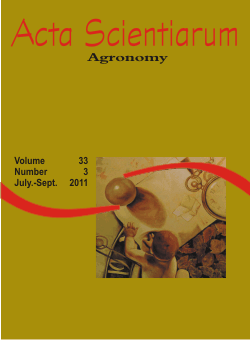<b>Comparison of methodologies for degree-day estimation using numerical methods</b> - doi: 10.4025/actasciagron.v33i3.6018
Resumo
The development of projects related to the yield of various crops has been greatly enhanced with the incorporation of mathematical models as well as essential and more consistent equations which enable a prediction and greater approximation to their actual behavior, thus reducing error in estimate. Among the operations requiring further investigation are those related to crop growth, characterized by the ideal temperature for addition of dry matter. Due to the wide use of mathematical methods for representing, analyzing and attaining degree-day estimation as well as the great importance of sugarcane in the Brazilian economy, we carried out an evaluation of the mathematical models and numerical integration methods commonly used for estimating the availability of degrees-day for this crop in the region of Botucatu, in São Paulo State, Brazil. Integration models with discretization every 6 hours have shown satisfactory results in degree-day estimation. Conventional methodologies have shown satisfactory results when the estimation of degrees-day was based on the time-temperature curve for each day and for groups of 3, 7, 15 and 30 days. Through numerical integration method, the region of Botucatu showed a annual thermal availability average from 1,070.6 degrees-day for the sugarcane.Downloads
DECLARAÇÃO DE ORIGINALIDADE E DIREITOS AUTORAIS
Declaro que o presente artigo é original, não tendo sido submetido à publicação em qualquer outro periódico nacional ou internacional, quer seja em parte ou em sua totalidade.
Os direitos autorais pertencem exclusivamente aos autores. Os direitos de licenciamento utilizados pelo periódico é a licença Creative Commons Attribution 4.0 (CC BY 4.0): são permitidos o compartilhamento (cópia e distribuição do material em qualqer meio ou formato) e adaptação (remix, transformação e criação de material a partir do conteúdo assim licenciado para quaisquer fins, inclusive comerciais.
Recomenda-se a leitura desse link para maiores informações sobre o tema: fornecimento de créditos e referências de forma correta, entre outros detalhes cruciais para uso adequado do material licenciado.




















































